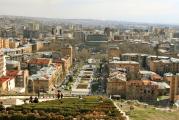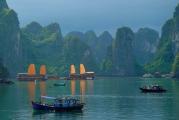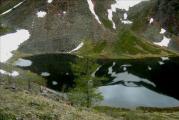The Kerch crossing is a strategic object. Kerch crossing is a strategic object From history
Summer has come. And with it comes the long-awaited holiday season. In which (like last year) many of our compatriots will again go to everyone’s beloved Crimea. Some will do it on the plane, others will choose single ticket by train and bus, well, someone will probably go to Crimea by car. This means that he will not only make an exciting road trip, but will also become part of a short and inexpensive, but quite real sea cruise- sailed from Taman to Crimea and back on one of the ferries of the Kerch ferry crossing. And if so, then I propose to get acquainted in advance with the future ships of your planned trip by looking under the cat, where photographs and brief characteristics of all currently operating car ferries across Kerch Strait.
Currently, passengers are transported from the port of Kavkaz to the Crimea terminal of the port of Kerch and in the opposite direction by ferries: “Olympiada”, “Crimea”, “Glykofilousa III”, “Protoporos IV”, “Major Chapichev”, “Pobeda”.
Ferry "Glycofilous III".
Ferry "Olympiad"(formerly "Dorieus").
Capacity - 600 passengers, 120 cars / 16 cargo vehicles.

Ferry "Protoporos IV".

Ferry "Major Chapichev"(formerly "Glycofilous-II").
Capacity - 500 passengers, 160 passenger cars / 18 cargo vehicles.

Ferry "Pobeda"(formerly "Protoporos-VI").
Capacity - 500 passengers, 150 passenger vehicles.

Ferry "Crimea"(formerly "Ostfold").
Capacity - 600 passengers, 160 cars / 16 cargo vehicles.

In reserve are:
Ferry "Kerch 2".

Ferry "Eysk".
Capacity - 160 passengers, 16 cargo vehicles.

Ferry "Nikolai Aksyonenko".
Capacity - 260 passengers, 41 cars / 6 buses.
The cargo-passenger ferry “Olympiada” (“Olympiad”) became the second Greek ferry, which since July 16, 2014 has been transporting passengers and cars on the Kerch ferry.
The cargo-passenger ferry "Olympiada" was built as a "Superflex Golf", becoming the seventh in a series of 15 Ro-ro ferries with a special engine assembly of the Superflex 2000 project. The project was developed by PZ Trading, which also took over the sale of the ships. This series was built at two North East Shipbuilders shipyards in the UK.
The ferry "Superflex Golf" IMO: 8611532 was built under construction number 3007 at the Pallion shipyard. Launching took place on January 22, 1988. On June 17, 1988, construction was completed, but the ferry remained at the shipyard. In 1989, it was acquired by VR Shipping ApS and began operating under the flag of Denmark, with its home port of Korsoer.
In December 1994 it was sold to Islena de Navegacion S.A. and renamed "Antonio Machado". Operated under the flag of Spain, home port of Algericas. In July 2003, it was sold to EneRmaR Transporti Isole Sarde Srl., and began operating under the flag of Italy, with its home port of Reggio Calabria. In December 2004, it became owned by NGI Navigazione and was renamed Razzoli. In May 2008, the Razzoli ferry became owned by Rete Ferroviaria Italiana (RFI) and was renamed Reggio. In March 2012, the ferry was acquired by the Greek company Corfu Superflex I Ltd. The ferry was reconstructed. In May 2012, the ferry began operating again under the name "Dorieus", flying the flag of Greece, home port of Piraeus.
In July 2014, the ferry "Dorieus" was transferred to Diverior Shipping Ltd., transferred to the flag of Cyprus, home port of Limassol. From July 12 to 16, 2014, the ferry “Dorieus” sailed from the Port of Piraeus to the port of Caucasus under the new name “Olympiada” (“Olympiad”).
Cargo-passenger ferry "Olympiada" ("Olympiad") IMO: 8611532, flag Cyprus, home port of Limassol, was commissioned in 1989, building number 3007. Shipbuilder: North East Shipbuilders, Sunderland, UK. Owner: Diverior Shipping Ltd., Cyprus.
Main characteristics: Tonnage 918 tons, deadweight 1291 tons. Length 93.8 meters, width 15 meters, draft 3.2 meters. Speed 11.5 knots. Accommodates 600 people, 104 cars on the lower deck and 65 on the upper deck.
On the night of July 16-17, 2014, it performed a test circular flight, transporting 216 cars, 955 passengers and 10 buses. On August 24, he was damaged during a pile-up on the pier. The ferry remained on the line; the lighting mast in the port was broken. On October 10, in the port of Crimea, while leaving the coast, the pontoon pier was torn from its chains. November 02 in stormy weather conditions on the left steering column.
According to a message dated March 23, 2015, the ferry is for further repairs. The renovation work is expected to be completed by early April. On April 15, TechFlot completed the planned annual dock repair of the ferry "Olympiada" under the supervision of the Russian Maritime Register of Shipping. April 17 at 20:00 hours “Crimea - Caucasus” after a scheduled examination. On September 24, at 17:00 Moscow time, it struck a quay wall in the port of Crimea. As a result of the incident, 4 cars and 2 trucks on the ferry and the quay wall, according to preliminary data, measuring 5.0 x 2.0 x 1.5 meters were damaged. The vessel received a dent above the waterline in the area of the stem on the starboard side measuring 0.8 x 0.7 x 0.2 meters, seaworthiness was not impaired. There were no casualties, no water leaks in the hull, no sea pollution.
"Olympiad" (Dorieus) is the second of the Greek car ferries that has been carrying out transportation on the Kerch ferry crossing since July 16, 2014. Together with the ferry, Jonas should take on the main load of passenger transportation
and passenger transport through the Kerch crossing.
Story
Built in the UK to the Superflex 2000 design. The original name Superflex Golf was changed several times.
The ferry became the seventh in the series. Launching took place on January 22, 1988. On June 17, 1988, construction was completed, but the ferry remained at the shipyard.
In 2012, the vessel was reconstructed.
Kerch crossing
On July 12-16, 2014, he sailed from the port of Piraeus to the port of Caucasus. The ferry set off on this voyage under the new name Olympics.
On the night of July 16-17, it performed a test circular flight, transporting 216 cars, 955 passengers and 10 buses. On July 17 at 09:00 the ferry left the port of Kavkaz for its second voyage with 131 cars on board and 413 passengers. By the start of work, 2,200 cars were waiting on the line from the port of Kavkaz. The waiting time for loading personal vehicles reached 40 hours.

During the first day of operation of the ferry, the queue decreased by 1000 cars, and the waiting time was up to 30 hours. During the second day of operation, the queue was reduced to 500 cars, and the waiting time was up to 10 hours.
This mode of operation was accepted by the ferry operator as the normal mode and over the next day the number of trips was reduced, and the queue length was 600 cars with a loading waiting time of 11 hours.
On August 24, he was damaged during a pile-up on the pier. The ferry remained on the line; the lighting mast in the port was broken.




